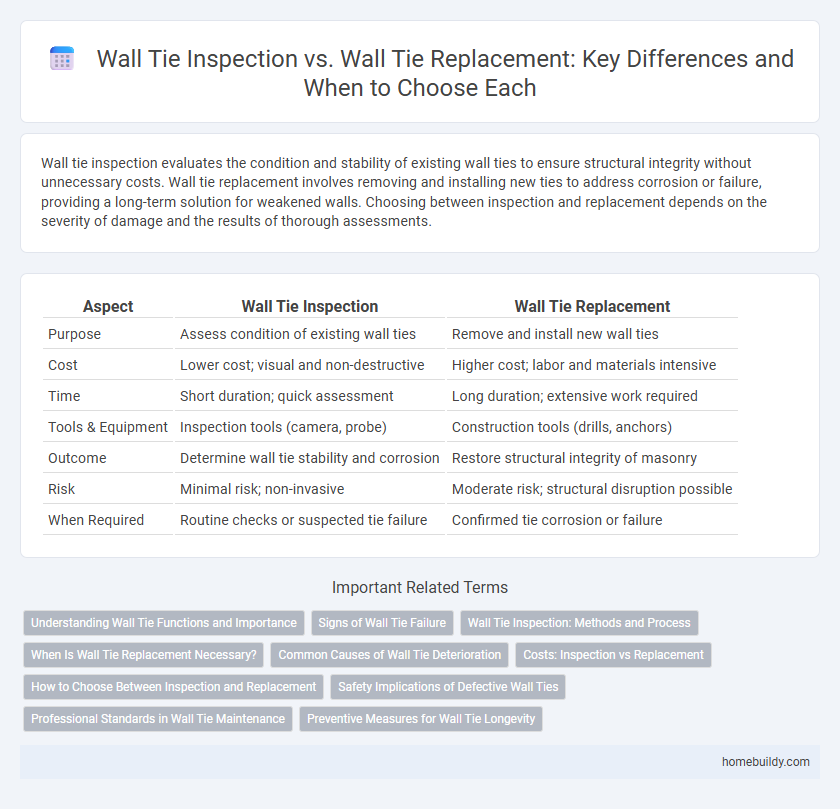Wall tie inspection evaluates the condition and stability of existing wall ties to ensure structural integrity without unnecessary costs. Wall tie replacement involves removing and installing new ties to address corrosion or failure, providing a long-term solution for weakened walls. Choosing between inspection and replacement depends on the severity of damage and the results of thorough assessments.
Table of Comparison
| Aspect | Wall Tie Inspection | Wall Tie Replacement |
|---|---|---|
| Purpose | Assess condition of existing wall ties | Remove and install new wall ties |
| Cost | Lower cost; visual and non-destructive | Higher cost; labor and materials intensive |
| Time | Short duration; quick assessment | Long duration; extensive work required |
| Tools & Equipment | Inspection tools (camera, probe) | Construction tools (drills, anchors) |
| Outcome | Determine wall tie stability and corrosion | Restore structural integrity of masonry |
| Risk | Minimal risk; non-invasive | Moderate risk; structural disruption possible |
| When Required | Routine checks or suspected tie failure | Confirmed tie corrosion or failure |
Understanding Wall Tie Functions and Importance
Wall tie inspection is essential for assessing the structural integrity and corrosion status of existing ties, ensuring they continue to secure masonry walls effectively to the supporting framework. Understanding the wall tie function highlights their role in distributing loads and preventing wall bulging or collapse, which underscores the importance of timely identification of compromised ties through inspection. Wall tie replacement becomes necessary when inspection reveals significant deterioration or failure, restoring the building's stability and preventing further structural damage.
Signs of Wall Tie Failure
Signs of wall tie failure include bulging or leaning walls, cracked or damaged mortar joints, and visible corrosion on existing wall ties. Wall tie inspection is crucial to detect these issues early, using methods such as ultrasound or endoscopic cameras to assess hidden corrosion and structural integrity. When signs of significant deterioration are found, wall tie replacement ensures the stability of masonry walls and prevents costly structural damage.
Wall Tie Inspection: Methods and Process
Wall tie inspection involves non-destructive testing methods such as endoscopic examination, digital radiography, and ultrasonic testing to assess the integrity of metal ties embedded within masonry walls. The process includes detailed visual inspection, measurement of corrosion levels, and evaluation of wall tie placement using specialized equipment to detect defects without damaging the structure. Accurate wall tie inspection ensures early identification of potential failures, reducing the need for costly wall tie replacement and maintaining building safety.
When Is Wall Tie Replacement Necessary?
Wall tie replacement is necessary when inspections reveal significant corrosion, severe cracking, or complete failure of the ties, compromising the structural integrity of masonry walls. Visible signs such as bulging walls, displaced brickwork, or excessive dampness indicate that the wall ties can no longer effectively stabilize the wall. Professional inspection using techniques like endoscopic examination or ultrasonic testing helps determine whether repair or full replacement is required to maintain building safety and compliance with structural standards.
Common Causes of Wall Tie Deterioration
Wall tie deterioration commonly results from moisture ingress, leading to corrosion of metal ties and subsequent loss of structural integrity. Repeated freeze-thaw cycles and poor building maintenance accelerate the weakening of wall ties, causing them to fail over time. Regular wall tie inspection detects early signs of rust, cracking, or displacement, enabling targeted replacement before extensive damage occurs.
Costs: Inspection vs Replacement
Wall tie inspection costs typically range between $300 and $600, providing a cost-effective way to assess structural integrity without immediate commitment to repairs. Wall tie replacement expenses can vary from $2,000 to $15,000 depending on wall size, material, and extent of damage, significantly exceeding inspection costs. Investing in thorough inspection helps identify issues early, potentially reducing the need for costly full replacement and extensive brickwork.
How to Choose Between Inspection and Replacement
Choosing between wall tie inspection and replacement depends on the condition, age, and type of the ties used in the structure. Wall tie inspection employs techniques like endoscopic examination or magnetic resonance imaging to detect corrosion and structural integrity without invasive procedures. Wall tie replacement is necessary when inspections reveal significant deterioration or failure, ensuring the reinforcement of masonry walls and preventing potential structural damage.
Safety Implications of Defective Wall Ties
Defective wall ties compromise the structural integrity of masonry walls, leading to potential wall separation and collapse hazards. Inspecting wall ties regularly mitigates these safety risks by identifying corrosion or failure before critical damage occurs. Replacing damaged wall ties restores strength and stability, ensuring long-term safety for building occupants and preventing costly structural failures.
Professional Standards in Wall Tie Maintenance
Wall tie inspection involves a thorough examination of the metal ties securing masonry to the structural frame, assessing corrosion, deformation, and anchorage integrity following professional standards such as BS EN 846-5 and ASTM E2273. Wall tie replacement is recommended when inspection reveals significant deterioration compromising structural stability, necessitating installation of corrosion-resistant ties in accordance with industry protocols. Adhering to established standards ensures safety, longevity, and compliance in wall tie maintenance, minimizing risks of wall failure.
Preventive Measures for Wall Tie Longevity
Regular wall tie inspections identify early signs of corrosion, movement, or detachment, enabling timely maintenance to prevent structural damage. Preventive measures such as applying protective coatings and improving drainage around wall ties significantly extend their service life. Replacing damaged wall ties is costlier and more invasive, making routine inspections and maintenance essential for long-term wall tie longevity.
Wall tie inspection vs Wall tie replacement Infographic

 homebuildy.com
homebuildy.com